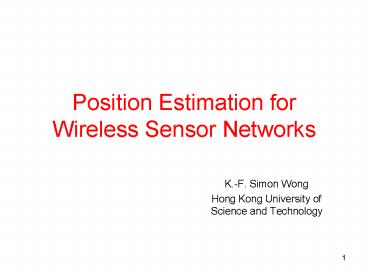Position Estimation for Wireless Sensor Networks - PowerPoint PPT Presentation
1 / 32
Title:
Position Estimation for Wireless Sensor Networks
Description:
Centroid algorithm, APIT, HS/GHoST, DV-HOP and so on. Centralized algorithm. ... Construct close-neighbor vector (CNV) for information exchanges. 12. Collecting CNV ... – PowerPoint PPT presentation
Number of Views:157
Avg rating:3.0/5.0
Title: Position Estimation for Wireless Sensor Networks
1
Position Estimation for Wireless Sensor Networks
- K.-F. Simon Wong
- Hong Kong University of Science and Technology
2
Outline
- Introduction
- Position estimation scheme
- ISOMAP
- Distributed Algorithm
- Applications
- Position-Based Routing
- Location-Identifying Service
- Illustrative Results
- Conclusion
3
Introduction
4
Background
- Ad hoc network
- High mobility, high power nodes and moderate
network size. - Wireless sensor networks (WSNs)
- Low mobility, low power nodes and large size
(typically more than 50 nodes). - We focus on WSNs in this work.
5
Position Estimation in WSNs
- Hot topic
- Position-based routing
- Route according to the nodes location instead of
IDs. - Location-based services
- Identify the location at which sensor reading
originate. - Enclosed environment, such as car park, hospital,
theme park and so on.
6
Previous Work
- Two approaches for location-identifying
- Approaches based on precise measurement.
- Landmark-based approaches.
7
Approaches Based on Precise Measurement
- GPS, RADAR, APS and so on.
- Expensive hardware.
- Power inefficient.
- Good for Ad hoc networks, but not suit for WSNs.
8
Landmarks-based Approaches
- Centroid algorithm, APIT, HS/GHoST, DV-HOP and so
on. - Centralized algorithm.
- Usually require high powered landmarks.
- Bandwidth-inefficient flooding.
- Good approaches, if decentralize the algorithm,
and avoid flooding.
9
Our Contribution
- No expansive hardware
- Reduction in implementing cost.
- Less power consumption.
- Distributed Algorithm
- Collects information from certain number (C) of
neighbors (C 30 in our experiment). - Each node estimates its own coordinates.
- Landmark-free
- Landmarks are optional.
10
Position Estimation Scheme
11
Quantized Distance
- Measuring rough distances between one-hop
neighbors by power controlling.
2
4
5
1
3
CNV
- Construct close-neighbor vector (CNV) for
information exchanges.
- Inf
- 2
- 3
- 2
Host ID
Distance levels
12
Collecting CNV
- Collecting CNV to construct distance matrix.
13
ISOMAP
- Given
- a matrix of quantized distance of a number of
nodes - Finding
- the corresponding coordinates that fits the
matrix and minimize error.
0 4 inf 3 4 0 2 1 inf 2 0
3 3 1 3 0
0 0 0 3 0 4 0 6
14
Distributed Algorithm
- Clearly, centralized algorithm.
- Challenging to be distributed.
- Demonstrates the idea in the following slides.
15
bootstrap node
Every node obtains its own CNV at the beginning.
normal users
16
First iteration
The bootstrap asks the C neighbors to send CNV,
and runs isomap.
17
First iteration
Coordinates computed
The bootstrap sends the computed coordinates to
the C neighbors.
Not computed yet
18
Second iteration
Each node collects CNV from the C closest
neighbors.
19
If there is L neighbors already computed new
coordinates, perform isomap to compute its OWN
coordinate. (L is typically 10 for C 30)
Second iteration
20
The computed nodes diffuses outwards.
Third iteration
21
Finally done!
Nth iteration
22
Applications
23
Position Based Routing
- Plenty of existing algorithms.
- Most of them depend on GPS.
- We are not proposing a new one and only gives
important location information for these
algorithms. - A simple algorithm is used
- Greedy forwarding.
24
Location-based Service
- Relative location in position-based routing.
- Landmarks can fix the rotation/reflection
- No high powered landmarks.
- No landmarks flooding.
- Small number (around 10).
25
Illustrative Results
26
Relative Coordinates
27
Global Coordinates
28
Routing EffectLow Failure rate
29
Positioning EffectLower Angular Error
30
Positioning EffectLow Distance Error
31
Conclusion
32
Conclusion
- Presented a position estimation system in WSNs.
- Focus in two applications
- Position-based routing.
- Location-based services.
- Simulation results are shown to illustrate the
performance.































